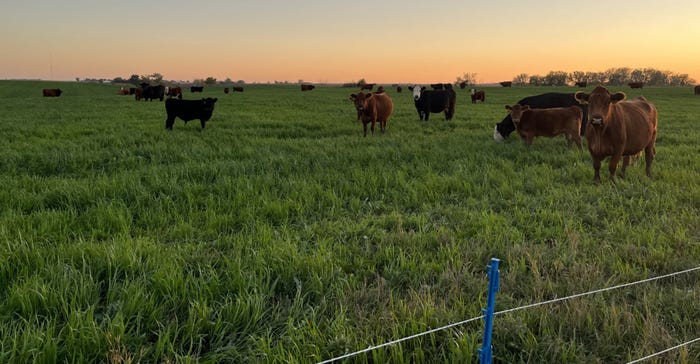
With a nod toward resource sustainability and growing consumer demand, some farmers find that milling oats have a place in their crop rotations.
Ben Dwire of Arco, Minn., is one of them. As a third-generation farmer, he is focused on improving soil health and has found that milling oats works well in his crop rotation. He is going on his eighth year of no-till, raising milling oats, rye, corn and soybeans. He and his wife, Kristi, and their two daughters farm 550 tillable acres and also raise Red Angus-cross cattle. About a third of the acreage is small grains, mostly milling oats. Another third is corn, and another third is food-grade soybeans. Two-thirds of the farm is covered with cover crops.
“Raising milling oats is a fun challenge and seems daunting, but it is attainable,” Dwire says. “It’s not that difficult.”
At first glance, low prices might dissuade some farmers from considering oats in rotation, yet Dwire says other benefits more than make up for that, such as straw sales; full-season cover crop options that improve soil health, provide nitrogen for the next crop and forage for grazing livestock; and crop rotation advantages.
“Oats also do a lot of heavy lifting on the soil health front,” he adds. “Please don’t let your ground sit there and get fat and lazy. It wants to work for you. With oats, you can grow your own nitrogen; you’ve got a real window to work with it, and you can graze it.”
Tips for growing oats
Dwire considers test weight as a key indicator of quality milling oats, aiming for 38 pounds per bushel or more. He pays attention to five factors to boost the weight: oat varieties, fungicides at flag-leaf stage, high fan speed on the combine, use of multiple augers to run grain through, and use of a grain vacuum.
It all starts with variety selection, he says. Dwire reviews three-year university trials from Minnesota, South Dakota and North Dakota, noting data on high test weight, high grain yield, resistance to rust, kernel plumps and thins percentage, straw strength and maturity. Good straw strength is needed to hold the top weight of plants, and rust resistance is needed in his area due to disease pressure. He likes full-season varieties, such as Pearl and Dion, as well as an early-season variety, Rushmore.
With the farm’s one-third rotation schedule, small grains always follow soybeans, not corn. Small grains are more susceptible to diseases in cornfields, he says. He selects fields that allow for early planting, so flowering and head fill occur before the hot time of summer.
“On the flip side, if you have fields that are good and struggle in August with being drier, those fields are good to use,” he adds.
He bases his seeding rate on plants per acre, planning on 1.2 million to 1.3 million in the final stand. Thus, he starts with 1.5 million seeds per acre, factoring in a loss of 10% to 20%. Calibrating the drill is crucial since there is so much variation in seed size, Dwire says.
When it comes to chemical use, Dwire keeps in mind cattle grazing later in the year. Fall weed control works best for him. Dandelions are the biggest weed challenge. Fungicide is critical for crown rust control. Timing is important, he notes, adding that the plant’s flag leaf must be present. He likes using a double fan sprayer tip for wide leaf coverage.
To increase test weight at harvest, Dwire either swaths or straight-cuts, depending on plant and weather conditions. He turns up the combine fan speed to blow out light material. He runs the crop through various augers and dryers to get more dust and chaff out, and boost test weight. Oats will not crack like corn and soybeans. You want to break off the tip of the oat and to shine it up, he adds. As a final step, he runs oats through a grain vacuum, since he has found that easily adds an extra pound to test weight.
Cover crops and cattle
With two-thirds of the farm acreage in cover crops, the Dwires have fresh forage available for their own cattle and custom-grazing. They usually no-till additional cover crop varieties into oat stubble immediately after harvest, such as red clover, cereal rye, turnips, radishes and rape seed. Lightweight oats that blow out from the back of the combine serve as an oat cover crop.
“About mid-October is when we try to get cattle out grazing, about 45 to 60 days after planting the cover crop,” Dwire says. Enough cattle numbers are put on the field to graze it off in 45 to 60 days.
“We usually try to be done before the snow gets too deep, because moving animals home can become difficult,” he adds.
Market options
Even with high consumer demand for oat products, Dwire says few farmers in the U.S. grow oats —demand is met with milling oats coming from Canada. “It’s hard to get food-grade contracts in the U.S.,” he says. “They fill up fast.”
Dwire is on his fifth year of selling contracted oats through Grain Millers, based in Eden Prairie, Minn. “They really are a great company to work with,” he adds. Other buyers include General Mills, Quaker and some local elevators.
To learn more about Dwire’s oat management practices, watch this video from Albert Lea Seed:
Farmers lead soil health effort
Ben Dwire enjoys talking with other farmers about soil health as much as he does milling oats. Dwire is chair of the Minnesota Soil Health Coalition. The farmer-led coalition, organized as a nonprofit in 2019, is in the middle of a three-year business plan. The Farmer asked Dwire to share more about the organization.
What is unique about the coalition, given the plethora of soil health programs and organizations available, and why should Minnesota farmers consider joining? Ben Dwire: Our farmer-mentor network is one of the most unique things about our organization. Our farmer-mentors are experienced in implementing soil health practices on their own farms and volunteer their time to help mentor other farmers. They speak about their soil health experiences and economics. They educate youth, conduct research and mentor USDA staff and other ag professionals. Almost all of them are Minnesota Ag Water Quality Program-certified and have personal experience with the Environmental Quality Incentives Program, Conservation Stewardship Program and other cost-share programs. Asking questions and for advice from one of your peers can really help farmers avoid some of the pitfalls in the beginning their soil health journeys. It can also save a lot of money along the way.
The coalition is in the middle of a three-year business plan to develop its brand and programming. What are a few highlights? Any goals met yet? We have had success with our mentor network and continue to grow it. We have also had success organizing educational events. We have hosted or partnered on 24 educational events this spring. We reach about 10,000 farmers a year with soil health information. We are also conducting on-farm research on compost and the microbiology impact on the soil, and we just submitted a proposal for a nutrient density study on crops grown using soil health practices.
Please share more about one of the goals, the collaboration with Central Lakes College for a five-year agreement for an ag-based soil health research center. What would this entail? Hiring researcher(s)? Investment in equipment or facilities? This is a long-term goal that we have not yet implemented. Soil health research is an important area for us, and we are still working to determine how to set up a research system where we can parallel research done at the university and on the farm to meet publication standards, as well as getting information to farmers in real time.
Board members are asked to serve as mentors and share their regenerative ag story with farmers and the public. Please share some of your activities in 2021. Last year I sat on several farmer panels and spoke at soil health field days throughout the state on topics like no-till, cover crop usage and adding livestock into cropping systems — as did most of our board members. We also took turns sitting at the coalition’s booth and talking to people at Farmfest, the Minnesota Cattlemen’s summer tour and the Minnesota Ag Expo. My wife and I were featured in a video produced by the Economist magazine, talking about things farmers are doing to reduce the amount of nutrient and soil runoff in the Gulf of Mexico.
For more information about the coalition, visit mnsoilhealth.org.
About the Author(s)
You May Also Like






